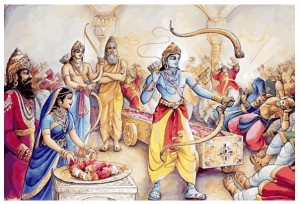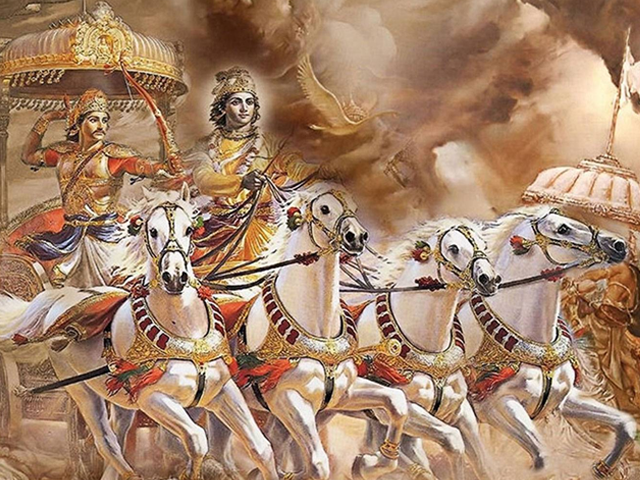In this paper, an attempt is made to study the Ramayana and the Mahabharata, both of which represent the ethos of ancient India. The Ramayana. according to tradition, owes its origin to an extraordinary circumstance. A hunter’s arrow killed one of a pair of curlews. Moved to pity at this tragic incident, the Sage Valmiki cursed the fowler: he did so in verse, which came out spontaneously from his lips. This poetical expression of profound grief is said to have been the first ever verse composed and the sage, who became the author of the Ramayana is popularly called the ‘Adikavi’.
Anandaavardhana (who belongs to 9th century AD), the famous rhetorician analysing Valmiki’s state of mind as he reacted to the pathetic sight of the bird being killed, is of the opinion that the experience had not only culminated in the utterance of the first verse, but also gave rise to the idea of rasa in poetry.
According to tradition, the Mahabharata was penned by the elephant-headed deity Ganesa, as dictated by Sage Vyaasa. The oral transmission was through two classes of people: Sutas (bards in the royal courts)3 and Kusilavas (travelling singers). Before they were committed to writing, the epic stories gathered many accretions. Even after they were written down, additions and alterations continued. The extent of the changes that occurred explains the great popularity of the epics.
Although the epic stories are very old and some of them hark back to Vedic times, their present forms are of much later date. It is generally believed that the Mahabharata had attained its present form by about the fourth century A.D., whereas the Ramayana probably assumed its present shape a century or two earlier.
Tradition places the Ramayana earlier than the Mahabharata. The nucleus of the Mahabharata may have been older than that of the Ramayana, but in their present forms, the Ramayana appears to be the earlier work. The Ramayana is more ornate than the Mahabharata i.e., even more refined and sophisticated: the ballad style of the Mahabharata is not there. But the Ramayana is more or less a unified work. Much shorter than the Mahabharata, it does not show the jumble of diverse matters that are found in the Mahabharata.
Weber’s suggestion that Homer’s story of Helen and the Trojan War had exercised a deep influence on the Ramayana is not substantiated by reliable evidence since two allusions in the Ramayana to Yavanas (Greek and Ionians) have been proved to be spurious. As Wintrnitz says, “There is not even a remote similarity between the stealing of Sita and the rape of Helen, between the advance on Lanka and that on Troy, except only the remote similarity of motive between the bending of the bow by Rama and that by Ulysses”.
The Ramayana
The poet is an adept in characterization and this is displayed in a series of unparalleled portraits: For instance, Rama’s supreme sacrifice for the sake of his father; Lakshman’s obedience to his elder brother; the self-abnegation of Bharata in abjuring royal comforts during the absence of Rama; and the unflinching loyalty of Hanuman to his master8 are notable among them.
Among the women Sita is a glowing example of chastity and high-mindedness, the paragon of all domestic virtues. Rama is a model son, husband, brother, king, warrior and man. Lassen and Weber, followed by some other scholars, consider the story of Rama to be allegorical. Rama, they hold, symbolizes Aryan culture, and his expedition against Ravana represents the cultural domination of the southern regions by the Aryans.
Jacobi is one of those scholars who hold the opinion that this story is no allegory, but just an ancient Indian myth transformed into a massive narrative of earthly adventures. Monier Williams thinks that the story of the conflict between Rama and Ravana contains a moral allegory. It seeks to typify the great mystery of the struggle ever going on between the forces of good and evil.
However, some scholars have suggested that there is a philosophical allegory in the epic. The epic is highly valuable in another respect. It seeks to hold up lofty ideals in the life of the individual, the family, and society; it also holds out high political and economic ideals. It is in fact an epitome of Indian civilization, for the highest spiritual and metaphysical ideals are also set forth, stressing the transience of life so full of misery, and the eternal nature of the soul. While fate is recognized as extremely powerful, good actions and penance are stated to be the means overcoming it.

The verbiage, hyperbole, exaggeration, diffuseness, etc. are natural in most poetic literature. Therefore, the Ramayana could not be an exception. As Monier Williams puts it so beautifully, “It (the Ramayana) is like a spacious and delightful garden; teeming with fruits and flowers, watered by perennial streams, and even its most tangled jungle intersected with delightful pathways. In fact, most of the artistic drawbacks of the Ramayana are attributable to the later versifiers who altered the original production by Valmiki.
The Mahabharata
The Mahabharata is not a homogeneous and unified work of art. It is, to quote Winternitz, a ‘literary monster’ containing so many and multifarious things. It is a fact that, “the epic is more suited than any other book to afford an insight in to the deepest depths of the Indian people”.
Moreover like the Rig-Veda and the Upanishads, the Mahabharata contains beautiful poetry juxtaposed with philosophical or other topics that are, perhaps, to the ordinary reader, insipid. In the course of time, when the Buddhists assumed political power, they seized upon the popular Mahabharata as a convenient tool for the dissemination of their doctrines and moral principles. Similarly, the Jains too did not lose the opportunity to spread their doctrines among the masses through the framework of this popular epic.

The epic, thus, underwent changes which have made it a medley of miscellaneous matters. It is not, however, amorphous, nor is it meaningless. It has the single purpose of upholding the glory of Dharma and proclaiming the internal values of peace and tranquility in society. This phenomenon prompted Winternitz to say that if one has to believe that the epic is by one and the same hand, then it must be presumed that the author was at once a sage and an idiot, a finished writer and a wretched scribbler17. But according to some modern researchers, the Mahabharata is not one single poetic production at all, it is a literary complex. So, the presence of portions of varying merits in one and the same work is not surprising.
Impact on Society
Both the epics are essentially didactic and ethical in spirit. Hence, they are regarded as Dharma-Sastras and Niti-Sastras. They provide detailed guidelines for rulers, statesmen, law givers, and persons belonging to the various castes19. Both have tried to propagate the same message: It is virtue, not falsehood, that ultimately wins and prevails.
The pictures drawn in the epics of happiness, harmony and understanding in the domestic and social spheres are ideal. For instance, affection of parents, loyalty of brothers, love of wives, and obedience of children, have an irresistible effect on the minds of the reader. Monier Williams observes that they depict scenes of domestic affliction, and express those universal feelings and emotions which belong to human nature in all time and in all places.
Swami Vivekananda says that the epic reflects the national character of ancient India: her wisdom, her beauty and her power. Therefore, they are aptly called India’s national epics, India’s pride and treasure22. Of the two other great epics of the world, like the Iliad and Odyssey, it can be said that they remain as monuments of the human mind and as documents of human life and manners in ancient times. The Indian epics are no less interesting than their European counterpartes.
Conclusion
Thus, the life and literature of the Indian people beginning from the remote antiquity down to the present day have been largely influenced by these two great epics. In fact the story of Ramayana and many of the episodes of the Mahabharata are stock subjects, which appear over and over again in the later literatures. For example, many paintings and architectural and sculptural objects have also been designed after the Ramayana and the Mahabharata motifs. Even on the epigraphs and coins the influence of the epics is considerable.
They have become so popular and famous that they travelled far beyond the frontiers of India to the countries in the west, north, south, and southeast and to a great extent moulded their art and literature.
References
- De, S.K., History of Sanskrit Poetics, Vol-II p.135.
- Navlekar, N.R., A New Approach to the Ramayana. 267.
- VIDEHIL, 514-15.
- p.521.
- Monier William, I.F., Indian Wisdom, p.
- MacDonnell, A.A., A History of Sanskrit Literature, 262.
- IV 28-11-12.
- Vide Gospel of Sri Ramakrishna, Swami Nikhilannanda, Sri Ramakrishna math, Mylapore, Madras p.101.
- Swami Vivekananda, The Complete works, V, Advita Sharma, Calcutta, p. 415.
- Ruckert, F., Poetisches Tagebuch, Vol 500.
- Monier Williams, Indian Poetry. p.12.
- , 111.28, 29, 31 and 33.
- Ibid P. 114.
- G. XI.29 (References to the Bhagavad-Gita are according to the Nirnayan Sagar Press Edn. Bombay.)
- Ibid 28.
- V.S. Sukthankar, On the meaning of the Mahabharata pp.25-27.
- V.S. Sukthankar, Critical studies in the Mahabharata p. 412.
- Cited in HIL, Vol p.
- Ibid 413.
- The Great Epics on India, pp. 58-84 and pp 403-5.
- Indian Wisdom 439.
- Vide Swami Vivekananda, The Complete Works Vol IV. 100-101.
- For a detailed study of the influence of the epics on the life and literature of India and abroad, Vide CHI, II Part -1.
Dr. S. Kuppusamy
Lecturer, Department of Indian History
University of Madras, Chennai.
Sources: Journal of Indian History and Culture, September 2005


